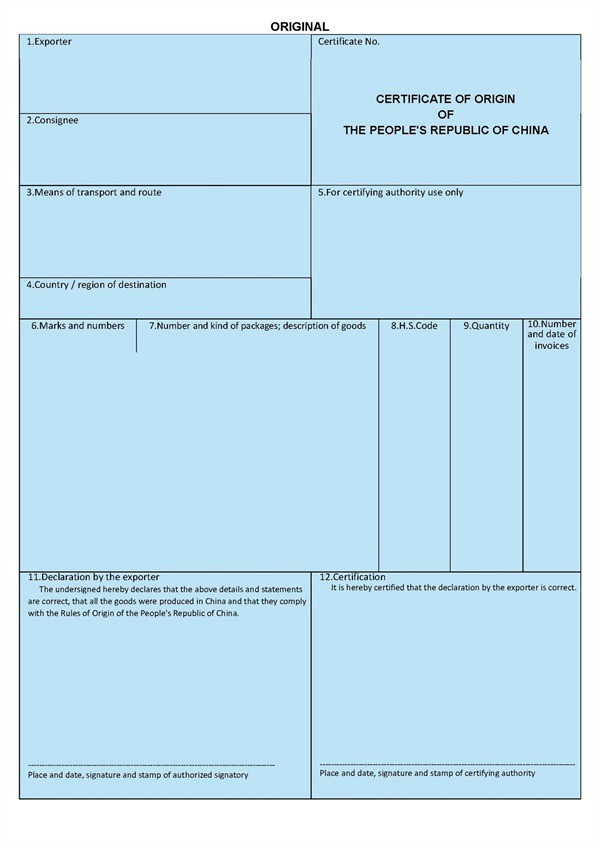I. What is a Certificate of Origin (CO)?
A Certificate of Origin (CO) is an official document issued by the government or relevant authorities of the exporting country to prove the origin or place of production of the exported goods. It plays a vital role in international trade as it serves as an important basis for the importing country to determine tariff treatment, implement trade control, conduct trade statistics, and enforce anti-dumping and countervailing measures.
II. Types of Certificates of Origin
General Certificate of Origin (CO): This is the most common type of certificate of origin, which is used to prove that the goods originate from a specific country or region and are entitled to the normal tariff (most-favored-nation) treatment of the importing country.
Preferential Certificates of Origin: These certificates can enjoy more favorable tariff treatment than the most-favored-nation treatment. They include the Generalized System of Preferences Certificate of Origin (FORM A) and regional preferential certificates of origin (such as FORM E, China-Korea FTA certificates, etc.).
Special Certificates of Origin: These are certificates of origin for specific industries or commodities, such as the EU agricultural products certificate of origin.
III. The Role of Certificates of Origin
Tariff Preferences: Under the framework of Free Trade Agreements (FTAs), for example, under the China-ASEAN Free Trade Area (ACFTA), the FORM E certificate allows goods exported from China to Thailand to enjoy a preferential tariff of 0%-5%, or even zero tariff.
Customs Clearance Requirements: Some countries require a certificate of origin as a condition for import. Without the certificate, goods may be detained, fined, or returned.
Trade Statistics: It helps the importing country track the source of goods and conduct trade data analysis.
Anti-dumping/Countervailing: To prove whether the goods come from a country or region subject to trade restrictions.
IV. The Process of Applying for a Certificate of Origin
Online Declaration Entry:
Log in to the “China International Trade Single Window“, and enter the “Certificate of Origin” module under “Standard Edition Application”.
Or log in to “Internet + Customs“, and enter the “Tax and Fee Business”—”Certificate of Origin Management” module.
Maintenance of Enterprise Information:
For the first time applying for a certificate of origin, enterprises need to enter the “Enterprise Information”—”Enterprise Information Maintenance” module, fill in relevant information by themselves or synchronize the customs enterprise general qualification information.
After filling in the information, check “Applicant’s Commitment” and click the “Submit” button. When the “Synchronization Status” shows “Synchronization Successful”, the information maintenance is successful.
Certificate Application:
After completing the maintenance of enterprise information, enter the “Certificate Application” module, select the applicable type of certificate of origin for certificate information filling.
After filling in the information, save it, check “Applicant’s Commitment”, and then submit the certificate of origin application.
Certificate Review:
The issuing authority reviews the submitted certificate of origin information. Applicants can check the review status through the “Document Status” in “Certificate Inquiry”.
Certificate Printing and Issuance:
Non-self-printing mode: Print on a form certificate with a dot matrix printer, or print the certificate to be issued on A4 white paper with an ordinary printer, affix the enterprise seal, and sign by the authorized applicant. It will be issued on-site by the issuing customs.
Self-printing mode: Print the certificate of origin on A4 white paper with a color printer with automatic double-sided printing function. The printed certificate has already loaded the customs and enterprise seals and signatures, and the enterprise does not need to go to the customs for issuance on-site.
V. Precautions
Certificate Validity: For example, the FORM E certificate is usually valid for 1 year, but some countries require it to be issued before the goods arrive at the port and do not accept retroactive issuance.
Risk of Certificate Withdrawal: Customs may conduct spot checks. If the origin standard does not meet the requirements, the tariff preferences may be canceled and fines may be imposed.
Post-issuance Certificate Issues: If the certificate is not applied for before shipment, a “post-issuance certificate” can be applied for. However, some countries do not accept it.
Post time: May-19-2025





